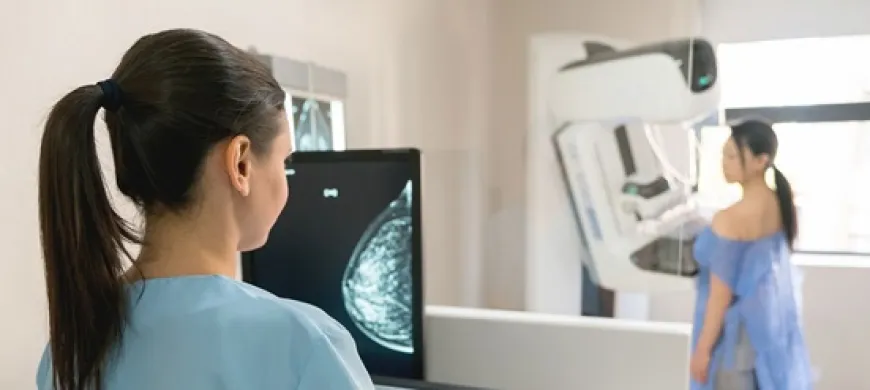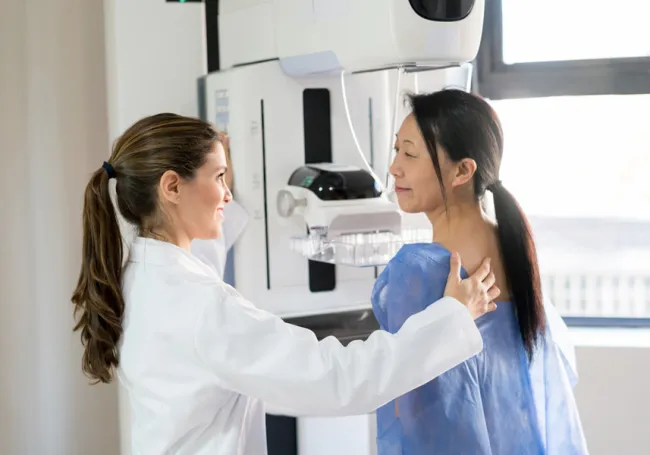Mammography
Diagnostic Imaging Services

Early Detection, Successful Treatment
Breast cancer is the second most common cancer
in women; about 1 in 8 U.S. women (13%) will develop breast cancer over the course of her lifetime. Breast cancer is also the second deadliest cancer for U.S. women, second only to lung cancer. However, it has been shown that regular screenings can significantly improve survival rates.
A mammogram is a safe, low-dose x-ray picture of the breast. It is currently the most effective method of detecting breast cancer in its earliest, most treatable stages. The American Cancer Society recommends regular yearly mammograms for women, beginning at the age of forty. Early detection can increase a woman's chances for successful treatment. Also, a mammogram can detect a tumor much earlier than it can be felt.
Enhanced Technology
3D mammography takes multiple images of breast tissue to create a multi-layered image, compared to a single image created by traditional mammography. It emits the same amount of radiation as a traditional mammogram, takes only a few seconds more to perform and causes no additional discomfort.The clearer 3D picture allows doctors to examine breast tissue one layer at a time to help make a more accurate diagnosis, thus helping to reduce false positives and the need for further testing.
3D mammography is particularly beneficial for women with dense breasts because the multiple, higher-quality images make it much easier for doctors to spot abnormalities than traditional mammography. Studies have shown that ultrasound can also help find breast cancers that can't be seen on a 2D mammogram. However, the cost of an ultrasound may not be covered by insurance. Traditional and 3D mammograms are fully covered by most insurance providers, including Medicare.

— Are you pregnant?
If you are pregnant, please discuss with your physician prior to scheduling a mammogram. Please also notify the schedulers when making your appointment, as well as the technician at the imaging center.
— Do you have breast implants?
If you have breast implants, please notify us when scheduling your appointment.
Mammography - Preparation
If you have had a mammogram at another facility, it is helpful for the radiologist if you are able to bring them with you to be used for comparison. You should not use powders, deodorant, or creams the day of your mammogram; it can affect the quality of your exam. To reduce any pain you may experience during the mammogram, you should abstain from drinking caffeine for a week prior to your appointment, and you may take Tylenol one hour in advance, pending your physician's approval.
Mammography - What to expect during the test
Typically, you will receive four x-rays, two pictures of each breast. The breast will be placed on the mammogram machine and pressed firmly between two plates, and a picture is taken. Compression may be uncomfortable, but not harmful to the breast. It is not unusual to receive an ultrasound to further evaluate the breast if recommended by the radiologist.
Mammography with Implants - Preparation
Please notify the schedulers when making your appointment if you have implants. Additional time is needed to acquire optimal mammographic images. If you have had a mammogram at another facility, it is helpful for the radiologist if you are able to bring them with you to be used for comparison. To reduce any pain you may experience during the mammogram, you should abstain from drinking caffeine for a week prior to your appointment, and you may take Tylenol one hour in advance, pending your physician's approval.
Mammography with Implants - What to expect during the test
Because breast augmentation can make it more difficult to visualize abnormalities, you will receive eight x-rays, four pictures of each breast. The breast will be placed on the mammogram machine and pressed firmly between two plates as a picture is taken. One set will include the entire breast and implant. Compression may be uncomfortable, but not harmful to the breast or to the implant. It is not unusual to receive an ultrasound to further evaluate the breast if recommended by the radiologist.
Mammography & Breast Density FAQs
When should I start getting screened?
We recommend standard or 3D mammograms for women
beginning at age 40. Women with risk factors and family
history should receive yearly mammograms.
What are the benefits of 3D mammography, compared to traditional mammography?
- A 27% increased in the detection of all breast cancers
- A 41% better detection rate for invasive breast cancers
- A 40% decrease in false positives
Is this test dangerous?
No. The risk of harm from radiation is very small when compared to the benefits of early breast cancer detection. Advancements in mammography have resulted in women receiving 50 times less radiation than they received 20 years ago, with...
No. The risk of harm from radiation is very small when compared to the benefits of early breast cancer detection. Advancements in mammography have resulted in women receiving 50 times less radiation than they received 20 years ago, with the risk of long-term effects being almost zero.
How long will it take?
Typically, no more than 20 minutes. If you have implants, it will take longer due to the additional images required.
What should I expect?
During a mammogram, images are taken of the breast.
Patients may feel a slight compression and minimal
discomfort. Some women also receive an ultrasound to
further evaluate the breast if recommended by a radiologist.
What should I wear?
A two-piece outfit is best because you will be asked to undress from the waist up. You should not use powders, deodorant, or creams the day of your mammogram. It can affect the quality of your exam.
When will I know the results?
One report will be mailed to you, and another report faxed to your doctor. This process takes between three to five days. Results are given the day of your mammogram should you or your doctor detect a problem in your breast (lump,...
One report will be mailed to you, and another report faxed to your doctor. This process takes between three to five days. Results are given the day of your mammogram should you or your doctor detect a problem in your breast (lump, nipple discharge, etc.).
Are there any restrictions after the test?
No, you may resume your normal activities and medications.
What is breast density?
Breasts are made up of a mixture of fibrous and glandular tissue and fatty tissue. Your breasts are considered dense if you have a lot of fibrous or glandular tissue but not much fat. Density may decrease with age, but there is little,...
Breasts are made up of a mixture of fibrous and glandular tissue and fatty tissue. Your breasts are considered dense if you have a lot of fibrous or glandular tissue but not much fat. Density may decrease with age, but there is little, if any, change in most women.
How do I know if I have dense breasts?
Breast density is determined by the radiologist who reads your mammogram. There are four categories of mammographic density. The radiologist assigns each mammogram to one of the categories. Your doctor should be able to tell you whether...
Breast density is determined by the radiologist who reads your mammogram. There are four categories of mammographic density. The radiologist assigns each mammogram to one of the categories. Your doctor should be able to tell you whether you have dense breasts based on where you fall on the density scale. 10% of women have almost entirely fatty breasts; 10% have extremely dense breasts; and 80% are classified into one of two middle categories.
Why is breast density important?
Having dense breast tissue may increase your risk of getting breast cancer. Dense breasts also make it more difficult for doctors to spot cancer on mammograms. Dense tissue appears white on a mammogram. Lumps, both benign and cancerous,...
Having dense breast tissue may increase your risk of getting breast cancer. Dense breasts also make it more difficult for doctors to spot cancer on mammograms. Dense tissue appears white on a mammogram. Lumps, both benign and cancerous, also appear white. So, traditional mammograms can be less accurate in women with dense breasts. However, 3D mammography provides better, more accurate images of dense breast tissue. If you have dense breast tissue, a 3D mammogram can detect more invasive breast cancers and provide more accurate results with fewer false positives. Talk to your doctor or the scheduler about 3D mammograms.
If I have dense breasts, do I still need a mammogram?
Yes. A mammogram is the only medical imaging screening test proven to reduce breast cancer deaths. Many cancers are seen on mammograms even if you have dense breast tissue, and 3D mammograms provide better images of dense breast tissue,...
Yes. A mammogram is the only medical imaging screening test proven to reduce breast cancer deaths. Many cancers are seen on mammograms even if you have dense breast tissue, and 3D mammograms provide better images of dense breast tissue, helping to detect more invasive breast cancers with fewer false positives.
Are there any tests that are better than a mammogram for dense breasts?
In breasts that are dense, cancer can be hard to see on a 2D mammogram. Studies have shown that ultrasound and magnetic resonance imaging (MRI) can help find breast cancers that can't be seen on a mammogram. However, both MRI and...
In breasts that are dense, cancer can be hard to see on a 2D mammogram. Studies have shown that ultrasound and magnetic resonance imaging (MRI) can help find breast cancers that can't be seen on a mammogram. However, both MRI and ultrasound, show more findings that are not cancer, which can result in added testing and unnecessary biopsies. Also, the cost of ultrasound and MRI may not be covered by insurance.
3D mammograms provide a better image of dense breasts, delivering more accurate results by detecting more invasive breast cancers and resulting in fewer false positives. A 3D mammogram is a good option for dense breasts, limiting the need for unnecessary callbacks and ultrasound or MRI screenings.
What should I do if I have dense breasts? What if I don’t?
If you have dense breasts, please talk to your doctor. Together, you can decide if 3D mammography is a the best fit for you, as well as which, if any, additional screening exams are right for you. If your breasts are not dense, other...
If you have dense breasts, please talk to your doctor. Together, you can decide if 3D mammography is a the best fit for you, as well as which, if any, additional screening exams are right for you.
If your breasts are not dense, other factors may still place you at increased risk for breast cancer — including a family history of the disease, previous chest radiation treatment for cancer and previous breast biopsies that show you are high risk. Talk to your doctor and discuss your history.
Even if you are at low risk, and have entirely fatty breasts, you should still get an annual mammogram starting at age 40.
